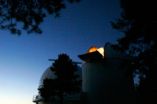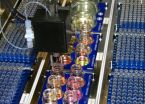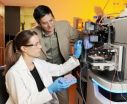(Press-News.org) PASADENA, Calif.—Astronomers from the California Institute of Technology (Caltech) and the University of Arizona have released the largest data set ever collected that documents the brightening and dimming of stars and other celestial objects—two hundred million in total.
The night sky is filled with objects like asteroids that dash across the sky and others—like exploding stars and variable stars—that flash, dim, and brighten. Studying such phenomena can help astronomers better understand the evolution of stars, massive black holes in the centers of galaxies, and the structure of the Milky Way. These types of objects were also essential for the recent discovery of dark energy—the mysterious energy that dominates the expansion of the universe—which earned last year's Nobel Prize.
Using the Catalina Real-Time Transient Survey (CRTS), a project led by Caltech, the astronomers systematically scanned the heavens for these dynamic objects, producing an unprecedented data set that will allow scientists worldwide to pursue new research.
"Exploring variable objects and transient phenomena like stellar explosions is one of the most vibrant and growing research areas in astrophysics," says S. George Djorgovski, professor of astronomy at Caltech and principal investigator on the CRTS. "In many cases, this yields unique information needed to understand these objects."
The new data set is based on observations taken with the 0.7-meter telescope on Mt. Bigelow in Arizona. The observations were part of the Catalina Sky Survey (CSS), a search for Near-Earth Objects (NEOs)—asteroids that may pose a threat to Earth—conducted by astronomers at the University of Arizona. By repeatedly taking pictures of large swaths of the sky and comparing these images to previous ones, the CRTS is able to monitor the brightness of about half a billion objects, allowing it to search for those that dramatically brighten or dim. In this way, the CRTS team identified tens of thousands of variables, maximizing the science that can be gleaned from the original data.
The new data set contains the so-called brightness histories of a total of two hundred million stars and other objects, incorporating over 20 billion independent measurements. "This set of objects is an order of magnitude larger than the largest previously available data sets of their kind," says Andrew Drake, a staff scientist at Caltech and lead author on a poster to be presented at the meeting of the American Astronomical Society in Austin on January 12. "It will enable many interesting studies by the entire astronomical community."
One of the unique features of the survey, Drake says, is that it emphasizes an open-data philosophy. "We discover transient events and publish them electronically in real time, so that anyone can follow them and make additional discoveries," he explains.
"It is a good example of scientific-data sharing and reuse," Djorgovski says. "We hope to set an example of how data-intensive science should be done in the 21st century."
The data set includes over a thousand exploding stars called supernovae, including many unusual and novel types, as well as hundreds of so-called cataclysmic variables, which are pairs of stars in which one spills matter onto another, called a white dwarf; tens of thousands of other variable stars; and dwarf novae, which are binary stars that dramatically change in brightness.
"We take hundreds of images every night from each of our telescopes as we search for hazardous asteroids," adds Edward Beshore, principal investigator of the University of Arizona's asteroid-hunting CSS. "As far back as 2005, we were asking if this data could be useful to the community of astronomers. We are delighted that we could forge this partnership. In my estimation, it has been a great success and is a superb example of finding ways to get greater value from taxpayers' investments in basic science."
The team says they soon plan to release additional data taken with a 1.5-meter telescope on Mt. Lemmon in Arizona and a 0.5-meter telescope in Siding Spring in Australia.
INFORMATION:
In addition to Djorgovski, Drake, and Beshore, the team includes staff scientist Ashish Mahabal, computational scientist Matthew Graham, postdoctoral scholar Ciro Donalek, and research scientist Roy Williams from Caltech. Researchers from other institutions include Steve Larson, Andrea Boattini, Alex Gibbs, Al Grauer, Rik Hill, and Richard Kowalski from the University of Arizona; Mauricio Catelan from Universidad Catholica in Chile; Eric Christensen from the Gemini Observatory in Hawaii; and Jose Prieto from Princeton University. The Caltech research is supported by the National Science Foundation. The work done at the University of Arizona is supported by NASA.
Astronomers release unprecedented data set on celestial objects that brighten and dim
2012-01-13
ELSE PRESS RELEASES FROM THIS DATE:
Caltech chemists devise chemical reaction that holds promise for new drug development
2012-01-13
PASADENA, Calif. -- A team of researchers at the California Institute of Technology (Caltech) has devised a new method for making complex molecules. The reaction they have come up with should enable chemists to synthesize new varieties of a whole subclass of organic compounds called nitrogen-containing heterocycles, thus opening up new avenues for the development of novel pharmaceuticals and natural products ranging from chemotherapeutic compounds to bioactive plant materials such as morphine.
The team—led by Brian Stoltz, the Ethel Wilson Bowles and Robert Bowles Professor ...
La Jolla Institute researchers identify pivotal immune cell in Type 1 diabetes in humans
2012-01-13
SAN DIEGO – (January 12, 2012) Researchers at the La Jolla Institute for Allergy & Immunology have proven – for the first time in human tissues -- the specific immune system T cells which trigger the destruction of type 1 diabetes in the pancreas. The finding is an important advance that verifies in humans several important disease characteristics shown in mouse studies and provides a key focal point for interrupting the disease process.
"This study marks the first time that the presence of beta cell-reactive T cells has been directly proven in pancreas tissues from ...
Girl power surges in India
2012-01-13
EVANSTON, Ill. --- By putting 18 million cracks in the proverbial glass ceiling, Hillary Clinton changed the way Americans think about women in politics, and new Northwestern University research suggests that an affirmative action law in India is doing the same for Indian women.
The research, to be published Jan. 12 in the journal Science, focused on the long-term outcomes of a law that reserved leadership positions for women in randomly selected village councils in India.
The law has led to a direct role model effect and is changing the way the girls as well as their ...
VTT: One-third of car fuel consumption is due to friction loss
2012-01-13
No less than one third of a car's fuel consumption is spent in overcoming friction, and this friction loss has a direct impact on both fuel consumption and emissions. However, new technology can reduce friction by anything from 10% to 80% in various components of a car, according to a joint study by VTT Technical Research Centre of Finland and Argonne National Laboratory (ANL) in USA. It should thus be possible to reduce car's fuel consumption and emissions by 18% within the next 5 to 10 years and up to 61% within 15 to 25 years.
There are 612 million cars in the world ...
Expectant mothers on antidepressants risk newborns with high blood pressure
2012-01-13
Mothers who take anti-depressants during pregnancy are more likely to give birth to children with persistent pulmonary hypertension (high blood pressure in the lungs) finds a study published today on bmj.com.
Persistent pulmonary hypertension is an increase in blood pressure in the lungs leading to shortness of breath and difficulty breathing. It is a rare, but severe disease with strong links to heart failure.
The study, carried out by researchers at the Centre for Pharmacoepidemiology at Karolinska Institutet in Stockholm Sweden, reviewed 1.6 million births in total ...
Mass media and health: Well-informed people eat better
2012-01-13
It is time to leave apart the belief that mass media are always a source of bad habits. Television, newspaper and the Internet, when used to get information, may turn out to be of help for health.
It is the conclusion of a study conducted by the Research Laboratories at the Fondazione di Ricerca e Cura "Giovanni Paolo II" in Campobasso which analyzed data from a sample of more than 1,000 people from the largest Moli-sani Project, the epidemiological study that recruited 25,000 subjects in Molise, a southern region of Italy.
The report, published on line in the International ...
New laboratory method uses mass spectrometry to rapidly detect staph infections
2012-01-13
Researchers from the Georgia Institute of Technology and the Centers for Disease Control and Prevention (CDC) have developed a new laboratory test that can rapidly identify the bacterium responsible for staph infections. This new test takes advantage of unique isotopic labeling combined with specific bacteriophage amplification to rapidly identify Staphylococcus aureus.
Quickly and accurately detecting infections caused by S. aureus is critical because the pathogenic bacterium causes a broad spectrum of infections, ranging from acute to chronic disease, which need to ...
Hydrogen advances graphene use
2012-01-13
Physicists at Linköping University have shown that a dose of hydrogen or helium can render the "super material" graphene even more useful.
Graphene has engendered high expectations whereof its extreme properties depend on the fact that it consists of a single sheet of carbon atoms. However the attraction forces between the atoms cause the sheets to be drawn to each other. One solution is to add atomic hydrogen between the layers.
Presented in the eminent journal Physical Review A, the researchers' calculations show that the hydrogen at a given concentration affects ...
Thousands of seniors lack access to lifesaving organs, despite survival benefit
2012-01-13
Thousands more American senior citizens with kidney disease are good candidates for transplants and could get them if physicians would get past outdated medical biases and put them on transplant waiting lists, according to a new study by Johns Hopkins researchers.
The Hopkins investigators estimate that between 1999 and 2006, roughly 9,000 adults over 65 would have been "excellent" transplant candidates and approximately 40,000 more older adults would have been "good" candidates for new kidneys. None, however, were given the chance.
"Doctors routinely believe and tell ...
LSUHSC research identifies 'bath salts' as new source of flesh-eating infection
2012-01-13
New Orleans, LA – A study led by Russell R. Russo, MD, a third-year Orthopaedic Surgery resident at LSU Health Sciences Center New Orleans School of Medicine, has identified a new source of life-threatening necrotizing fasciitis – "bath salts." The study, describing the first known case of necrotizing fasciitis from an intramuscular injection of the street drug known as "bath salts," is published in the January 2012 issue of Orthopedics, now available online.
Necrotizing fasciitis is an orthopedic emergency. The ability to quickly and accurately diagnose this rapidly ...


